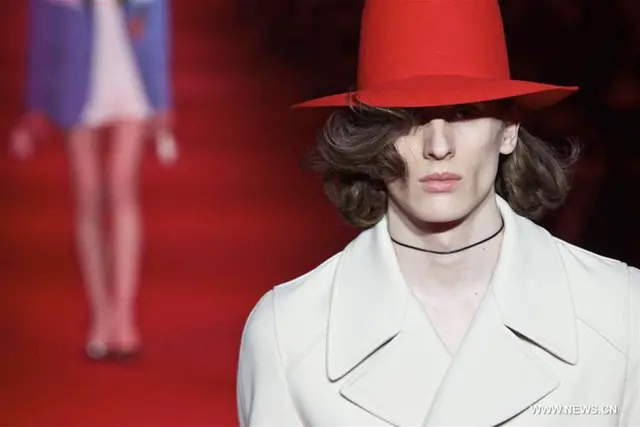Beijing is hosting an exhibition of rare Italian Renaissance art, where most of the works have never been seen outside of the country, let alone Asia.
An array of rare artifacts that once lay neglected in the storerooms of Italian museums, were finally given the chance to say "ciao" to the world at their global debut at the Capital Museum in Beijing last week.
These "sleeping beauties" were unveiled to the public on March 27 at the exhibition, Art, Culture and Daily Life in Renaissance Italy, which features 102 artworks and artifacts from 17 Italian institutions, including the Uffizi Gallery and Museo Nazionale del Bargello in Florence.
Ushering viewers back to the world of Renaissance art from the 14th to the 16th centuries, the pieces combine to form a fresh perspective on an era that is widely regarded as the cultural peak of world art.
A visitor poses in front of a replica of Vitruvian Man by Leonardo da Vinci at Art, Culture and Daily Life in Renaissance Italy, an exhibition at the Capital Musuem in Beijing through June 22.
According to Manuel Roberto Guido, directorate general of museums at the Ministry of Cultural Heritage and Activities and Tourism of Italy, the exhibition is a key achievement under the framework of the Sino-Italian agreement on cultural heritage cooperation that began in 2010, and is a major move toward improving Chinese people's recognition of Italian culture.
Since 2015, the ministry has operated their Sleeping Beauty program, which has established a database including lesser-known but important collections from all over Italy. More than 3,000 artifacts from 250 museums within a broad time spectrum-from ancient Rome to the modern era-have been registered with the program.
Federica Zalabra (right), curator of the exhibition, introduces armor from Renaissance Italy to visitors.
All the exhibits in the Beijing exhibition were sourced from this list.
"Except for a very few items, the vast majority of them had never left Italy before," Guido adds.
As the best known Renaissance art form, paintings dominate this collection-and this exhibition includes some of the biggest names in art history.
For example, Federica Zalabra, the Italian curator of the exhibition, recommends two paintings on display in particular, which were both created by Titian's workshop in the 16th century.
Titian painted Portrait of Charles V in Armor for the Holy Roman Emperor in 1548. Due to its popularity, Cosimo I de' Medici, the wealthy Italian banker who sponsored many of the top artists during the Renaissance, as well as other European nobles later ordered facsimiles of this portrait to be made.
The original work and all the other replicas were lost to history, barring one survivor. The facsimile currently on display, which was ordered by Medici, is the only remaining portrait in existence. Restoration of the painting was completed just before it was shipped to China for the exhibition.
In the other painting from Titian's workshop, an unnamed man's inner world and emotions are vividly reflected in his facial expressions.
A special section named Men and Women has been created at the exhibition, Zalabra explains, to reflect the focus on humanitarianism during the Renaissance era. While some paintings of the time portray aristocrats such as members of the House of Medici, many more depict ordinary people and scenes from their daily lives.
Most of the displayed paintings, part of a special program, had never left Italy.
To better explain a painting depicting a wedding between Eleanor de Medici and a duke, a set of costumes appearing in the work were also included in the exhibition.
"We wanted to display not only artworks but also a panorama of the time," she says. "Everyday articles from the Renaissance era were often neglected in previous exhibitions."
Still, Christianity remains a major theme throughout the highlighted oil paintings, like Madonna with Child painted on canvas by Francesco Morone and Maria's Nativity by Girolamo di Benvenuto rendered on wood panel. And, the oil-on-canvas work The Procession to Calvary is even believed to have been created by master painter Sandro Botticelli's workshop.
Rarely seen half-completed works by Federico Barocci, a late 16th century painter, are also on display in an attempt to show how Renaissance oil paintings were created.
Separately, several sculptures from ancient Rome and a few paintings from the Byzantine era are also exhibited to provide a reference for visitors about the origins of the Renaissance.
Although the Capital Museum is known for the intimate design of its galleries' interiors, Huang Xueyin, Chinese curator of the exhibition, switched to a simple, decorative style for this show to give visitors more room to view the paintings from a distance, without distractions.
"Exhibitions on Renaissance Italy have been held in China many times," Huang says. "But most of these were displays of fine art, and there was little emphasis on helping viewers understand why these works were created in the first place."
The Chinese team spent more than a year choosing the artifacts from the Sleeping Beauty list and drafting explanations on the works using background information.
"Context is important," she says. "We had to select works that would be accessible to the Chinese public, and also provide them with a glimpse into people's daily lives at that time."
The experience feels less like a visit to an art gallery, and more like a presentation on the social history of the Renaissance.
As the artifacts on display are a combination of functionality and high art, Guido also explains that they represent the early prototypes for what is known as modern Italian design today.
"This exhibition will trigger more collaboration in the cultural industry between China and Italy," Guido says. "It will build up a platform for a new Silk Road, which is about sharing knowledge, increasing dialogue and sustainable development."
(CHINA.ORG.CN)
 简体中文
简体中文

